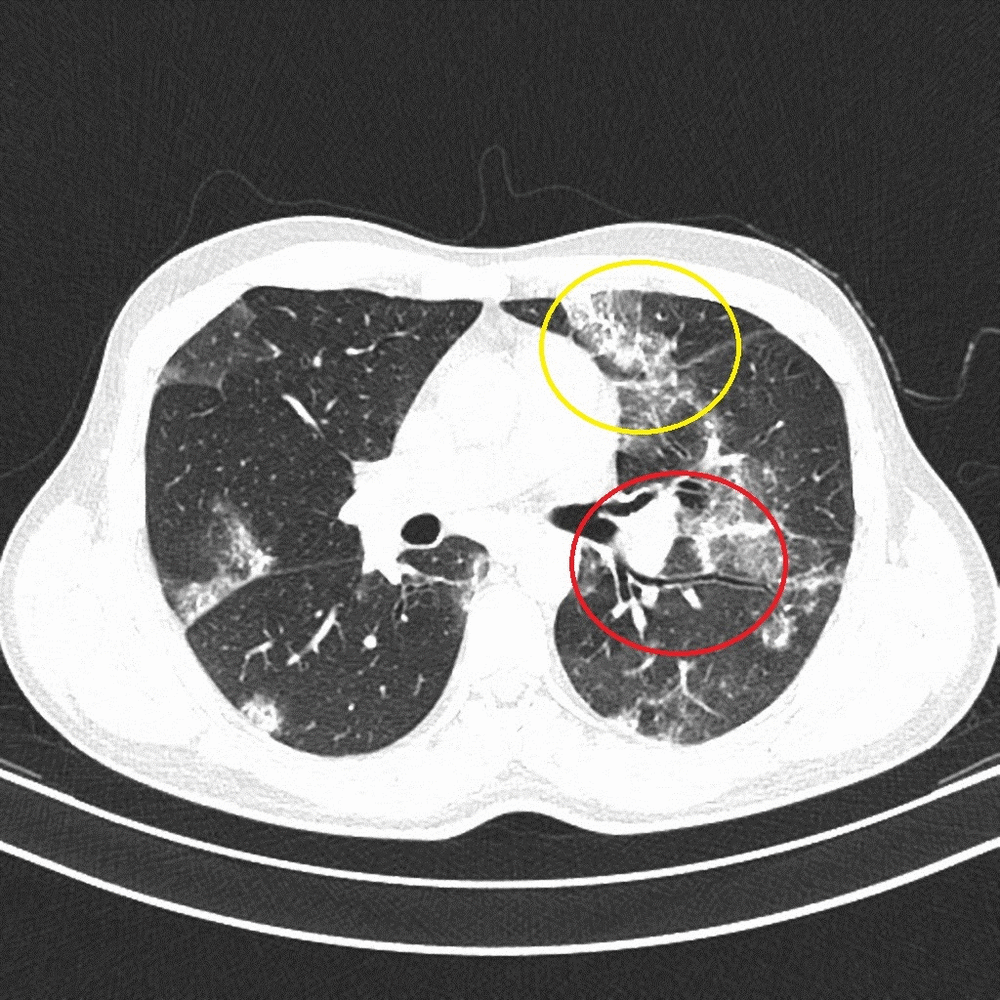Eosinophilic pneumonia CT: Difference between revisions
Jump to navigation
Jump to search
No edit summary |
No edit summary |
||
| (12 intermediate revisions by the same user not shown) | |||
| Line 1: | Line 1: | ||
__NOTOC__ | __NOTOC__ | ||
{{Eosinophilic pneumonia}} | {{Eosinophilic pneumonia}} | ||
{{CMG}} | {{CMG}}; {{AE}} {{MAD}} | ||
==Overview== | ==Overview== | ||
Characteristic CT findings of CEP include [[Ground glass opacification on CT|ground-glass attenuation]], [[Consolidation (medicine)|consolidation]], [[Nodules]], septal thickening, [[Pleural effusions]], and thickening of bronchovascular bundles. | |||
==CT== | ==CT== | ||
Computed tomography can help characterize the distribution of opacities and guide selection of an area of involvement for [[bronchoalveolar lavage]].<ref name="pmid22599359">{{cite journal| author=Rhee CK, Min KH, Yim NY, Lee JE, Lee NR, Chung MP et al.| title=Clinical characteristics and corticosteroid treatment of acute eosinophilic pneumonia. | journal=Eur Respir J | year= 2013 | volume= 41 | issue= 2 | pages= 402-9 | pmid=22599359 | doi=10.1183/09031936.00221811 | pmc= | url=https://www.ncbi.nlm.nih.gov/entrez/eutils/elink.fcgi?dbfrom=pubmed&tool=sumsearch.org/cite&retmode=ref&cmd=prlinks&id=22599359 }}</ref> | |||
== | Characteristic CT findings of CEP include:<ref name="pmid9772920">{{cite journal| author=Marchand E, Reynaud-Gaubert M, Lauque D, Durieu J, Tonnel AB, Cordier JF| title=Idiopathic chronic eosinophilic pneumonia. A clinical and follow-up study of 62 cases. The Groupe d'Etudes et de Recherche sur les Maladies "Orphelines" Pulmonaires (GERM"O"P). | journal=Medicine (Baltimore) | year= 1998 | volume= 77 | issue= 5 | pages= 299-312 | pmid=9772920 | doi= | pmc= | url=https://www.ncbi.nlm.nih.gov/entrez/eutils/elink.fcgi?dbfrom=pubmed&tool=sumsearch.org/cite&retmode=ref&cmd=prlinks&id=9772920 }}</ref><ref name="pmid8089322">{{cite journal| author=Ebara H, Ikezoe J, Johkoh T, Kohno N, Takeuchi N, Kozuka T et al.| title=Chronic eosinophilic pneumonia: evolution of chest radiograms and CT features. | journal=J Comput Assist Tomogr | year= 1994 | volume= 18 | issue= 5 | pages= 737-44 | pmid=8089322 | doi= | pmc= | url=https://www.ncbi.nlm.nih.gov/entrez/eutils/elink.fcgi?dbfrom=pubmed&tool=sumsearch.org/cite&retmode=ref&cmd=prlinks&id=8089322 }}</ref> | ||
{{ | * [[Ground glass opacification on CT|Ground-glass attenuation]] | ||
* [[Consolidation (medicine)|Consolidation]] | |||
* [[Nodules]] | |||
* Septal thickening | |||
* [[Pleural effusions]] | |||
* Thickening of bronchovascular bundles | |||
* The lesions usually involve the peripheral regions of the middle or upper lung zones. | |||
* The radiologic diagnosis of other causes of eosinophilic lung such as drug-induced pulmonary eosinophilia and hypereosinophilic syndrome is rarely possible. | |||
* Common CT findings of ABPA consist of [[bronchiectasis]], mucous plugging, bronchial wall thickening, [[atelectasis]], [[Consolidation (medicine)|consolidation]], areas of [[Ground glass opacification on CT|ground-glass attenuation]], and upper and central lung predominance.<ref name="pmid10966710">{{cite journal| author=Johkoh T, Müller NL, Akira M, Ichikado K, Suga M, Ando M et al.| title=Eosinophilic lung diseases: diagnostic accuracy of thin-section CT in 111 patients. | journal=Radiology | year= 2000 | volume= 216 | issue= 3 | pages= 773-80 | pmid=10966710 | doi=10.1148/radiology.216.3.r00se01773 | pmc= | url=https://www.ncbi.nlm.nih.gov/entrez/eutils/elink.fcgi?dbfrom=pubmed&tool=sumsearch.org/cite&retmode=ref&cmd=prlinks&id=10966710 }}</ref> | |||
[[ | [[File:Acute eosinophilic pneumonia.gif|300px|center|thumb|Acute eosinophilic pneumonia shows ground glass opacification (yellow circles) and thickening of bronchovascular bundles (red circles), source: Case courtesy of Dr Henry Knipe, Radiopaedia.org, rID: 39331]] | ||
[[ | [[File:Ezgif.com-optimize.gif|300px|center|thumb|Chronic eosinophilic pneumonia shows ground glass opacification (yellow circles) and thickening of bronchovascular bundles (red circles), source: Case courtesy of Dr Henry Knipe, Radiopaedia.org, rID: 39331]] | ||
==References== | |||
{{reflist|2}} | |||
{{WH}} | {{WH}} | ||
{{WS}} | {{WS}} | ||
Latest revision as of 04:18, 2 March 2018
|
Eosinophilic pneumonia Microchapters |
|
Diagnosis |
|
Treatment |
|
Case Studies |
|
Eosinophilic pneumonia CT On the Web |
|
American Roentgen Ray Society Images of Eosinophilic pneumonia CT |
|
Risk calculators and risk factors for Eosinophilic pneumonia CT |
Editor-In-Chief: C. Michael Gibson, M.S., M.D. [1]; Associate Editor(s)-in-Chief: Mohammed Abdelwahed M.D[2]
Overview
Characteristic CT findings of CEP include ground-glass attenuation, consolidation, Nodules, septal thickening, Pleural effusions, and thickening of bronchovascular bundles.
CT
Computed tomography can help characterize the distribution of opacities and guide selection of an area of involvement for bronchoalveolar lavage.[1]
Characteristic CT findings of CEP include:[2][3]
- Ground-glass attenuation
- Consolidation
- Nodules
- Septal thickening
- Pleural effusions
- Thickening of bronchovascular bundles
- The lesions usually involve the peripheral regions of the middle or upper lung zones.
- The radiologic diagnosis of other causes of eosinophilic lung such as drug-induced pulmonary eosinophilia and hypereosinophilic syndrome is rarely possible.
- Common CT findings of ABPA consist of bronchiectasis, mucous plugging, bronchial wall thickening, atelectasis, consolidation, areas of ground-glass attenuation, and upper and central lung predominance.[4]


References
- ↑ Rhee CK, Min KH, Yim NY, Lee JE, Lee NR, Chung MP; et al. (2013). "Clinical characteristics and corticosteroid treatment of acute eosinophilic pneumonia". Eur Respir J. 41 (2): 402–9. doi:10.1183/09031936.00221811. PMID 22599359.
- ↑ Marchand E, Reynaud-Gaubert M, Lauque D, Durieu J, Tonnel AB, Cordier JF (1998). "Idiopathic chronic eosinophilic pneumonia. A clinical and follow-up study of 62 cases. The Groupe d'Etudes et de Recherche sur les Maladies "Orphelines" Pulmonaires (GERM"O"P)". Medicine (Baltimore). 77 (5): 299–312. PMID 9772920.
- ↑ Ebara H, Ikezoe J, Johkoh T, Kohno N, Takeuchi N, Kozuka T; et al. (1994). "Chronic eosinophilic pneumonia: evolution of chest radiograms and CT features". J Comput Assist Tomogr. 18 (5): 737–44. PMID 8089322.
- ↑ Johkoh T, Müller NL, Akira M, Ichikado K, Suga M, Ando M; et al. (2000). "Eosinophilic lung diseases: diagnostic accuracy of thin-section CT in 111 patients". Radiology. 216 (3): 773–80. doi:10.1148/radiology.216.3.r00se01773. PMID 10966710.